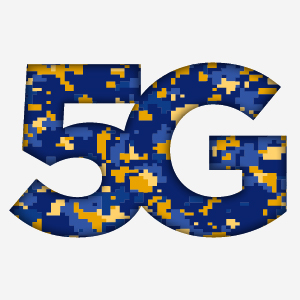The DoD’s 5G Military Strategy
Approval of the 2022 defense budget on March 15, 2022 provided another $600 million for the Department of Defense’s (DoD) “5G to Next G” Initiative [1]. This additional investment in the DoD program allows for continued progress in the Tranche 1 sites and the further launching of Tranche 2. In response to the current defense strategy update, the effort covers 5G (fifth generation mobile technologies) experimentation and testing at a total of 12 military test sites. The FY22 funding brings 5G military spending to over 1.85 billion since 2020. The 5G military initiative aligns with President Biden and the DoD’s top priorities of strengthening military advantages to counter threats from China, modernizing the military, and expanding research and development.
The first five 5G test sites initiated in October 2020, referred to as Tranche 1, specialize in different aspects of 5G technology and include:
- Hill Air Force Base, Utah–Dynamic Spectrum Utilization
- Fort Hood, Texas–Augmented Reality/Virtual Reality Training (Formerly at Joint Base Lewis-McChord, Washington)
- Marine Corps Logistics Base Albany, Georgia–5G Smart Warehousing (Vehicular)
- Naval Base San Diego, California–5G Smart Warehousing (Transshipment)
- Nellis Air Force Base, Las Vegas, Nevada–Distributed Command and Control [2]
The same year the DoD announced Tranche 2 test sites which included another seven military bases. These sites include:
- Naval Station Norfolk, Virginia—Ship-wide and Pier-side Connectivity
- Joint Base Pearl Harbor-Hickam, Hawaii—Enhancing Aircraft Mission Readiness
- Joint Base San Antonio, Texas—Augmented Reality Support of Maintenance and Training & 5G Core Security Experimentation Network
- Fort Hood, Texas—Wireless Connectivity for Forward Operating Bases (FOB) and Tactical Operations Centers (TOC)
- National Training Center (NTC) Fort Irwin, California—Wireless Connectivity for Forward Operating Bases (FOB) and Tactical Operations Centers (TOC)
- Camp Pendleton, California—Wireless Connectivity for FOBs and TOCs
- Tinker Air Force Base, Oklahoma–Bi-directional Spectrum Sharing Between DOD Communications Systems and Commercial 5G Systems [3]
These experiments are the largest full-scale 5G tests for dual-use applications in the world. The DoD’s primary goals for these 5G tests are to: promote technology development; assess, mitigate, and operate through 5G vulnerabilities; influence 5G standards and policies; and engage partners.
Current Developments and Relevance
Since the initial 2020 funding, the base test sites have been progressing in their respective areas. In June 2021, the DoD released the first update for Tranche 1 and hosted a demonstration of the $90 million prototype being tested at the Marine Corps Logistics Base in Albany, Georgia. The smart warehousing demonstration of 5G speeds displayed enhancements for the inventory management of autonomous vehicles, machine learning, and augmented/virtual reality uses combined with a zero-trust security strategy[4]. Hill Air Force Base in Utah, also a part of Tranche 1, celebrated its successful deployment of a private 5G network in December 2021 with additional upgrade goals scheduled for May 2022[5]. As of a January 2022 report, Tranche 2 sites are still being established. Officials hope they will reach maturity by the end of the year[6].
These tech advancements become even more critical because the U.S. is not the only country attempting to integrate 5G technology with its military. Michael Brown, director of the Pentagon’s Defense Innovation Unit, calls China’s strides in the 5G realm “shocking and alarming.” Brown considers the U.S. in a superpower race with China to launch full-scale military 5G usage[7]. Interference to the system from Russia poses another threat. The latest U.S. National Defense Strategy emphasized, “Success no longer goes to the country that develops a new technology first, but rather to the one that better integrates it and adapts its way of fighting.”[8]
 Benefits of 5G Military Usage
Benefits of 5G Military Usage
5G technology unlocks immense benefits that surpass previous networks’ capabilities and allow for additional integration of resources. While the most prominent improvements are the increased speed, reduced latency, and better reliability, there are many other benefits that apply to the military specifically. Since 5G includes more software and cloud capabilities that were previously unavailable with 4G, the military can decentralize their command centers. Having a functionally integrated but physically separate command center decreases vulnerability and makes the centers harder for enemies to target[9]. This software and location mobility enables the network to be reconfigured spontaneously and increases flexibility which is crucial on the warfront.
5G’s boosted data rates of 20-100 times faster than any current network speeds provide access to near real-time data and the power to sustain Internet of Things (IoT) connectivity that was previously unattainable[10]. This feature is an integral part of mobilizing the military’s Joint All-Domain Command and Control (JADC2) strategy and interconnected missions[11]. Additionally, 5G embeds encryption, network slicing, and other new privacy controls necessary for a secure network[12].
As the DoD collaborates with commercial organizations for 5G production, the military can influence the development and technology standards to support military requirements. These revolutionary results are only possible if the challenges of security and implementation are solved.
Challenges with Incorporating 5G
Even with the additional security capabilities, protecting the network from bad actors remains a primary concern. Especially in scenarios where the military is operating in hostile environments, secure 5G infrastructure may not be available. Installation in such areas can be particularly costly and infeasible[13]. Another weakness of the new network is prevalent signal disruption by physical objects such as buildings and rain. This interference comes in addition to the intentional interruption and eavesdropping by enemies, which compromises the reliability and integrity of the system[10].
Throughout the entire experimentation, production, and implementation process, the DoD must be extremely vigilant to confirm that the network components are safe and uncover new vulnerabilities through continual testing. Zero trust plays a massive role in 5G systems since it employs a significant amount of third-party hardware and software. Each application and device adds to the possible attack surface, necessitating additional precautions.
The digital refresh rate raises questions about long-term viability and return on investment. With discussions of 6G already underway, Kelly Marchese, Principal for Deloitte Consulting LLP, says that during the experimentation phase, test crews must work quickly but also ensure that they assess a wide enough scope of options and prepare for new adaptations. “Otherwise, by the time the defense application for 5G is ready to be rolled out, it may already be dated,” Marchese said. She described their philosophy as, “think big, start small, scale fast.”[13]
The Future of Military 5G
This modernization effort with 5G is an imperative step for the military in advancing technologies. The future lies in combining the speed, security, and bandwidth of 5G with AI and machine learning to derive the most reliable, comprehensive intelligence[10]. Excellence and efficiency in current research and testing paves the way for expedited innovation in the coming years.
Chris Bates, Specialist Leader with Deloitte Consulting LLP, believes that tech companies should view this as a massive opportunity to invest and play a vital role in assisting the DoD to achieve and roll out 5G capabilities and support national and economic security[14].
The new defense strategy is set to release in early 2022 and will offer more insight into the latest updates, directives, and priorities.
Visit our website to learn more about how Carahsoft brings together proven vendors with powerful 5G solutions and our upcoming events surrounding the latest 5G initiatives.
[1] “Department of Defense 5G Investment in Fiscal 2022,” GovWin from Deltek, https://iq.govwin.com/neo/marketAnalysis/view/Department-of-Defense-5G-Investment-in-Fiscal-2022/6297?researchTypeId=1&researchMarket=
[2] “New 5G challenge to incentivize open architecture solutions,” C4ISRNET, https://www.c4isrnet.com/smr/5g/2022/01/28/new-5g-challenge-to-incentivize-open-architecture-solutions/
[3] “Pentagon names seven new bases for 5G test beds,” C4ISRNET, https://www.c4isrnet.com/battlefield-tech/it-networks/5g/2020/06/04/pentagon-names-seven-new-bases-for-5g-test-beds/
[4] “Department of Defense Successfully Demonstrates a 5G Network for Smart Warehouses,” U.S. Department of Defense, https://www.defense.gov/News/Releases/Release/Article/2650242/department-of-defense-successfully-demonstrates-a-5g-network-for-smart-warehous/#:~:text=The%20Department%20of%20Defense’s%20(DOD,built%20in%20the%20United%20States.
[5] “DoD Kicks Off 5G Dynamic Spectrum Sharing Experimentation at Hill AFB,” U.S. Department of Defense, https://www.defense.gov/News/Releases/Release/Article/2859222/dod-kicks-off-5g-dynamic-spectrum-sharing-experimentation-at-hill-afb/
[6] “Pentagon to Launch New 5G Challenge to Support Military Sites,” Potomac Officers Club, https://potomacofficersclub.com/news/pentagon-to-launch-new-5g-challenge-to-support-military-sites/
[7] “Defense Department Further Accelerating 5G Development,” National Defense Magazine, https://www.nationaldefensemagazine.org/articles/2021/1/7/defense-department-further-accelerating-5g-development
[8] “Why the World’s Militaries are Embracing 5G,” IEEE Spectrum, https://spectrum.ieee.org/lockheed-martin-5g
[9] “Military 5G Testing Will Pave the Way for Modernization,” FedTech, https://fedtechmagazine.com/article/2021/05/military-5g-testing-will-pave-way-modernization
[10] “What 5G Means to the Military,” Military + Aerospace Electronics, https://www.militaryaerospace.com/rf-analog/article/14188341/military-5g-communications
[11] “How the Joint All-Domain Command and Control Will Use 5G to Improve Mission Effectiveness,” Carahsoft, https://www.carahsoft.com/community/carahsoft-5g-jadc2-mission-effectiveness-blog-2021
[12] “Take 5: 5G Cybersecurity,” Deloitte, https://www2.deloitte.com/us/en/pages/consulting/articles/take-five-on-5g-cybersecurity.html
[13] “Department of Defense 5G Strategy Implementation Plan: Advancing 5G Technology & Applications Securing 5G Capabilities,” United States Department of Defense, https://www.cto.mil/wp-content/uploads/2020/12/DOD-5G-Strategy-Implementation-Plan.pdf
[14] “Take 5: 5G and the DoD,” Deloitte, https://www2.deloitte.com/us/en/pages/consulting/articles/take-5-5g-dod.html







